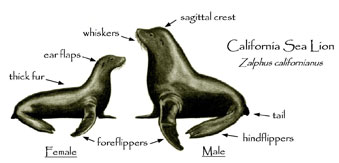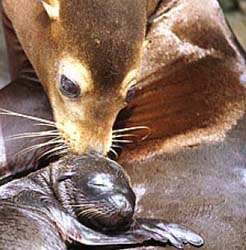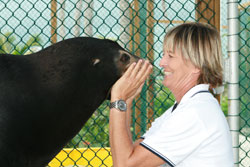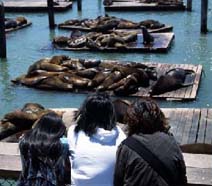Where Do Sea Lions Live? Learn Natural History

Who Are These Big “Dogs”?
California sea lions first appeared in the fossil record about 120,000 to 220,000 years ago. Today, they are known for their intelligence, playfulness, and noisy barking. Their color ranges from chocolate brown in males to a lighter, golden brown in females. Males may reach 850 lbs. and seven feet in length. Females grow to around 200-400 lbs. and up to six feet in length.

Sea lions have a "dog-like" face, and at around five years of age, males develop a bony bump on top of their skull called a sagittal crest. These members of the Otariidae or walking seal family have external ear flaps and large flippers that they use to "walk" on land. The trained "seals" in zoos and aquariums are usually California sea lions.
California sea lions are found from Vancouver Island, British Columbia to the southern tip of Baja California in Mexico. They breed mainly on offshore islands, ranging from southern California's Channel Islands south to Mexico, although a few baby sea lions have been born on all natural beaches, Año Nuevo and the Farallon Islands in central California. There is a distinct population of California sea lions at the Galapagos Islands. A third population in the Sea of Japan became extinct, probably during World War II.
Sea Lions Are Adapted To Live On Land & In The Sea
A common question about sea lions is, do sea lions live on land or in the sea? Sea lions are adapted for movement on land as well as in the water. Wing-like front flippers have a bone structure similar to that in our arms and hands. Swimming with these flippers propels the sea lion forward, while the hind flippers steer. Both pairs of flippers enable a sea lion to walk on land. California sea lions are very social animals, and groups often rest closely packed together at favored haul-out sites on land called colonies, or float together on the ocean's surface in "rafts." They are sometimes seen porpoising, or jumping out of the water, presumably to speed up their swimming. Sea lions have also been seen "surfing" breaking waves.
 Kalika, one of our females, posing for the camera
Kalika, one of our females, posing for the camera
California sea lions are opportunistic eaters, feeding on prey such as squid, octopus, herring, rockfish, mackerel, and small sharks. In turn, sea lions are preyed upon by Orcas (killer whales) and great white sharks.
Most baby sea lion pups are born in June or July and weigh 13-20 lbs. They nurse for at least five to six months and sometimes over a year. Mothers recognize pups on crowded rookeries through smell, sight, and vocalizations. Pups also learn to recognize the vocalizations of their mothers. Breeding takes place a few weeks after birth. Males patrol territories and bark almost continuously during the breeding season.
There’s A Lot To Learn From Pinnipeds
 Pups are born on land and may nurse anywhere from six to twelve months.
Pups are born on land and may nurse anywhere from six to twelve months. Most studies observe Pinnipeds when they’re on land while pupping, breeding, or molting. Little is known about pinniped behavior at sea including diving, migrating, habitat use, feeding strategies, and social interactions.
Scientists study Pinnipeds to learn about their natural history, reproduction, and behavior. The information helps when scientists try to save species that are endangered.
Scientists are now using compact satellite transmitters to track seal movements. With this new technology, scientists can virtually dive and swim with seals. Some scientists use a small computer call a time-depth recorder or TDR. The TDR is temporarily glued to the back of the pinniped and eventually falls off then the animal comes ashore later in the year to molt. The TDR records the time and depth measurements and stores the data until it is transmitted to a satellite. The satellite calculates the animal’s position and then sends the data to the laboratory for analysis.
Scientists at National Geographic have designed Crittercams. Safely worn by wildlife, Crittercams capture video, sound, and other information, giving us rare views of the private lives of animals. By allowing us this animal’s-eye view, Crittercams help to solve scientific mysteries. What we learn from Crittercams helps us protect the very animals that wear them.
How have people affected sea lions?
 Kim Terrell with Murray, our only male Sea Lion
Kim Terrell with Murray, our only male Sea Lion More than 7,000 years ago, California sea lions were hunted by the Chumash and Nicoleño Indians on the Channel Islands for subsistence. In the late 1800s they were hunted commercially for their hides. The impact of harvesting on sea lion populations has never been clear.
Since the Marine Mammal Protection Act was passed in 1972, the sea lion population has grown at a healthy increase of 10% each year. However, California sea lions continue to be shot by fishermen over competition for fish, particularly salmon. California sea lions often are seen in salmon spawning grounds, but in some cases, eat more lampreys than salmon. Lampreys (a type of fish) are parasites of salmon.
 People feeding sea lions at pier 39 in San Francisco led to millions of dollars in damages to docksand boats.
People feeding sea lions at pier 39 in San Francisco led to millions of dollars in damages to docksand boats. Pesticides and heavy metals in the ocean may impact sea lions. In one study, the tissues of females that had aborted pups had much higher concentrations of DDT than females who carried their pups to term.
Marine debris is a threat to sea lions. They can become entangled in nylon fishing nets or plastic packaging materials, causing severe injury or drowning. Sea lions also ingest plastic debris, which can cause obstructions in the digestive tract. Keeping our seas and beaches clean has a huge impact on the health of not just sea lions but all marine life.
Feeding wild marine animals has led to numerous problems, including millions of dollars of damages to docks and boats caused by the animals looking for more handouts. Though tempting to approach a sea lion, remember that these are wild animals and a safe distance protects both you and the animal from harm.

